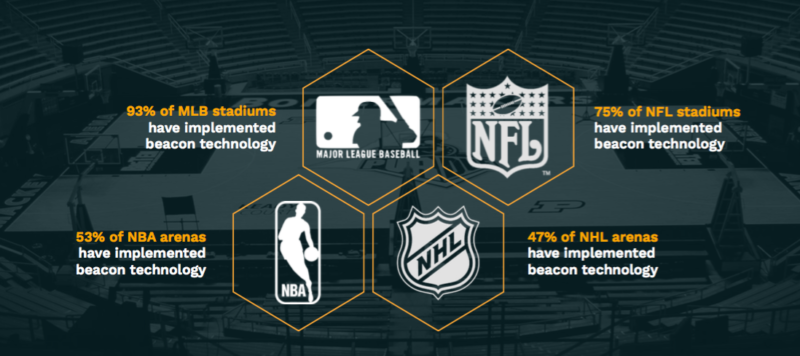Report: 93 percent of US baseball stadiums have deployed beacons
Sports teams that have deployed beacons and proximity technologies have seen an ROI as big as 40X in incremental revenue.
When people think of proximity marketing, they tend to think beacons. However, beacons are just one of several location technologies within the category. Others include NFC, WiFi, geofencing (and its variations) and others (smart lighting, magnetic positioning).
Collectively, these technologies can be used to help bring people into stores or venues, identify relevant audiences and help track offline conversions. Unacast’s Proxbook Report tracks the progress and adoption of proximity marketing, and beacons in particular. Its latest report focuses on adoption of proximity marketing by sports teams and at mega-events, such as SXSW, Mobile World Congress and CES.
The Q2 Proxbook Report found significant adoption of beacons among North American sports teams and stadiums. For example, the report says that 93 percent of Major League Baseball stadiums are now using beacons.
More interesting than the adoption data are the case studies featured in the report. While many people have never directly experienced beacon-based notifications or indoor marketing, there are a growing number of success stories.
The Proxbook Report says that “teams that have deployed beacons and proximity technologies have seen an ROI as big as 40X from incremental merchant revenues alone within the first season.”
A number of National Basketball Association and several European sporting events case studies are presented. The NBA examples include the Golden State Warriors, Milwaukee Bucks, Atlanta Hawks, Cleveland Cavaliers, Orlando Magic and marketing partners such as McDonald’s.
According to the report, the Warriors and Hawks teams were able to successfully sell seat upgrades within their arenas using beacon-driven push notifications to team-app users:
- Warriors: Beacons accounted for nine percent of all seat upgrades during the season.
- Hawks: Beacons accounted for 11 percent of all seat upgrades during the season.
Fans with their team’s app installed received notifications as they entered the stadium of better seat availability, which they could then purchase on the spot through the app. The Warriors were also able to boost sales of team merchandise using proximity marketing and push notifications to fans within the arena. The report adds that the teams covered their indoor marketing infrastructure/beacon-installation costs “from seat-upgrades alone, halfway into the season.”
In the McDondald’s example, the QSR chain sponsored The Milwaukee Bucks’ app and reached fans who had the app installed. McDonald’s content and messaging were pushed through the app as fans later crossed geofences created around 125 local Milwaukee-area restaurants.
The report estimates that there are roughly 8.2 million proximity sensors currently deployed globally. Just over six million are beacons; the rest are NFC sensors and WiFi access points. The report also cites third-party forecasts that by 2020, 400 million beacons will be deployed on a global basis.
While that number may be inflated, beacons and other proximity marketing deployments are clearly growing. The particular challenge with beacons is gaining opt-in participation from users.
However, those challenges can be overcome in several ways. Google’s Eddystone beacon standard can push notifications using the Chrome browser, rather than through an app. Mobile Wallets can be used as the app-foundation for push notifications. Finally, some companies (e.g., Gimbal) are building app networks that utilize pre-installed apps on users’ phones.
Increasingly, as the report suggests, marketers and businesses will use a cocktail of location technologies to reach consumers and to do offline attribution. Over time, it won’t matter as much whether the tech behind proximity marketing is beacons, WiFi, smart lighting or magnetic positioning. The focus will instead be about trying to engage the consumer in context.
Opinions expressed in this article are those of the guest author and not necessarily MarTech. Staff authors are listed here.
Related stories


